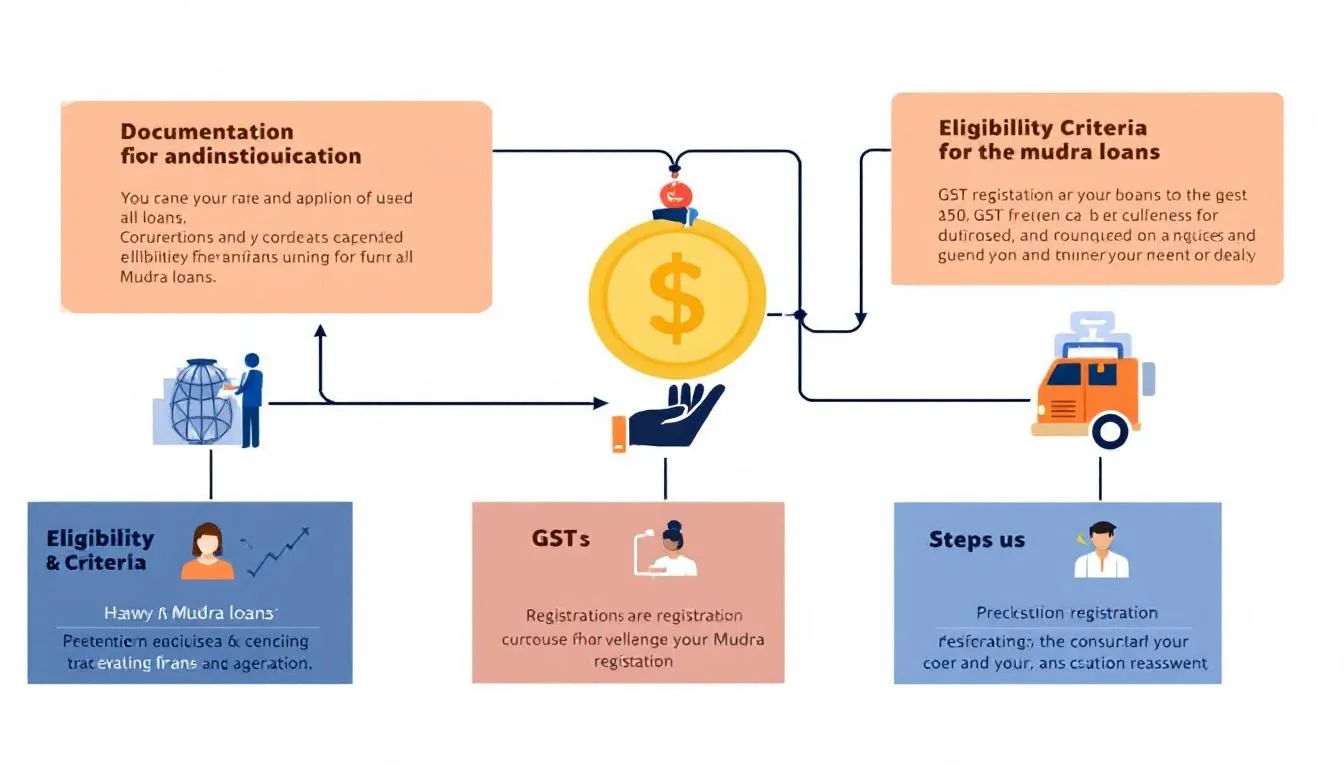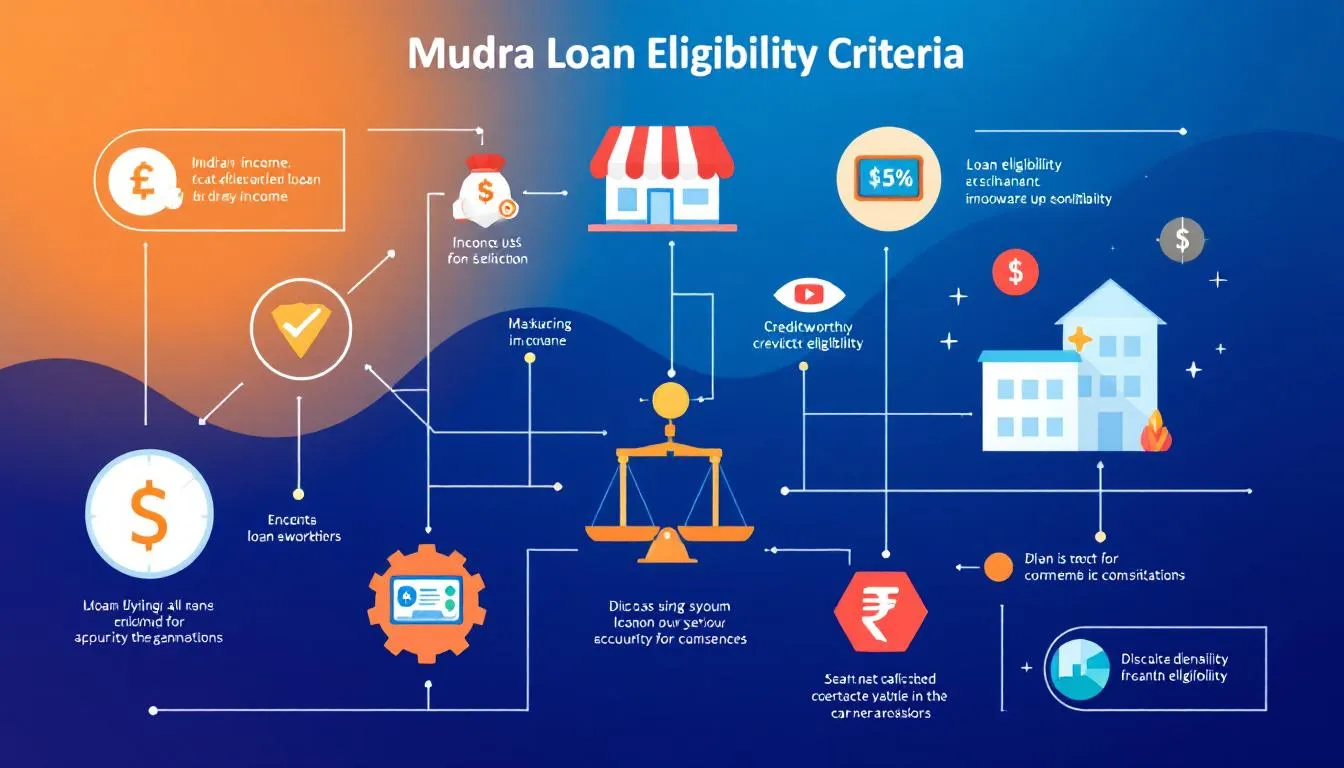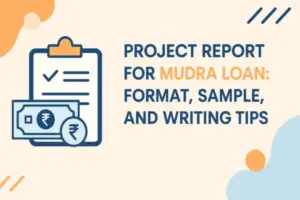Table of Contents
Can you get a Mudra loan without GST registration? The answer is yes. If your business turnover is below ₹40 lakh, GST registration is not mandatory for securing a Mudra loan. This article will guide you through the eligibility criteria, necessary documents, and practical tips to help you successfully apply for a Mudra loan without GST registration.
Key Takeaways
Mudra loans, aimed at supporting small and micro-enterprises in India, do not legally require GST registration unless turnover exceeds ₹40 lakh, making them accessible to a broader range of businesses.
Udyam registration is recommended to enhance loan approval chances, providing proof of business legitimacy, despite not being mandatory for Mudra loans.
Small business owners can improve their Mudra loan prospects by maintaining accurate financial records, using alternative documentation, and approaching public sector banks that adhere more closely to government guidelines.
Introduction
The Mudra loan scheme, launched under the Pradhan Mantri Mudra Yojana (PMMY), is designed to promote entrepreneurship and provide financial assistance to small and micro-enterprises in India. It categorizes loans into three types: Shishu (up to ₹50,000), Kishore (₹50,001 to ₹5 lakh), and Tarun (₹5,00,001 to ₹10 lakh). Despite the benefits, many small business owners hesitate to apply due to a lack of registration, fearing the complexities and potential rejections.
Navigating the complexities of Mudra loans, GST, and Udyam registration is essential for small business owners. This post addresses common concerns and offers actionable insights to help you through the loan application process smoothly.
This post explores the necessity of Udyam registration, the role of GST registration, and eligibility criteria for Mudra loans without these registrations. It also discusses challenges faced by small business owners and practical solutions, highlighting government initiatives and best practices to improve loan approval chances.
By the end of this post, you’ll understand the Mudra loan process, necessary documentation, and strategies to obtain a loan without GST registration. We’ll demystify the Mudra loan process for you.
Understanding Mudra Loans

Mudra loans are part of a government-backed initiative aimed at promoting entrepreneurship among small business owners by providing them with financial support tailored to their needs. These loans are specifically intended for non-corporate, non-farm small and micro-enterprises, enabling them to access the necessary capital to grow and sustain their businesses.
The Mudra loan program categorizes loans into three distinct types: Shishu, Kishore, and Tarun. Shishu loans are up to ₹50,000, Kishore loans range from ₹50,001 to ₹5 lakh, and Tarun loans cover amounts from ₹5,00,001 to ₹10 lakh. This tiered structure allows businesses at different stages of growth to access appropriate financial support.
The Indian government launched the Pradhan Mantri Mudra Yojana (PMMY) to provide financial assistance to micro-enterprises and small businesses. Through this initiative, the government aims to boost the accessibility of Mudra loans, particularly emphasizing support for those without GST registration. These loans are offered through a network of banks, Non-Banking Financial Companies (NBFCs), Micro Finance Institutions (MFIs), and regional rural banks.
Is Udyam Registration Mandatory for a Mudra Loan?
Udyam registration, while not legally mandatory for obtaining a Mudra loan, is strongly recommended because:
It serves as proof of business existence.
It can significantly enhance the chances of loan approval.
Many banks prefer Udyam registration as it adds credibility and legitimacy to the business.
For those who do not have Udyam registration, banks may accept alternative proofs of business existence, such as a trade license or establishment certificate. While Udyam registration is not a strict requirement, it certainly facilitates the loan application process and is beneficial for accessing various government benefits.
Do You Need GST Registration for a Mudra Loan?

GST registration is not mandatory for obtaining a Mudra loan if the business turnover is below ₹40 lakh. This threshold exempts many small businesses from the requirement, making Mudra loans more accessible. However, certain cases may still require GST registration, such as trading or service-based businesses dealing in taxable goods or services.
Real-world scenarios have shown that Mudra loans can be granted without GST registration. For instance, many small proprietors have successfully secured loans by providing alternative documentation and demonstrating their business’s financial health. This flexibility is crucial for supporting the growth of small enterprises that may not yet meet the GST registration criteria.
It’s important to note that while GST registration is not mandatory for most small businesses, some banks may still request it as part of their internal verification processes, particularly for higher loan amounts. Applicants should be prepared to provide additional documentation if requested, to ensure a smooth loan application process.
Eligibility Criteria for Mudra Loans Without GST Registration

Obtaining a Mudra loan without GST registration is possible, making these loans accessible to a wider range of small businesses. Applicants must submit identity verification documents like Aadhaar and PAN cards to secure a Mudra loan. Business ownership can be verified through documents like a trade license or establishment certificate.
Even in the absence of GST registration, applicants can still qualify for a Mudra loan by providing valid documents such as:
PAN card
Aadhaar card
Trade license
Utility bills These documents help establish the legitimacy and financial stability of the business.
Not having GST registration does not disqualify an applicant for a Mudra loan, although some banks may request additional documents to assess creditworthiness. For businesses with turnover below ₹40 lakh, GST registration is not mandatory but might be required for higher loan amounts or certain business types.
Challenges Faced by Small Business Owners
Small business owners often face significant challenges when seeking Mudra loans, particularly related to documentation. The lack of necessary documents such as income tax returns and GST registrations can impede their loan approval. Many small proprietors are unable to provide adequate documentation required by banks, including income proof, which can be a major obstacle in their loan application process.
Another major challenge is the complicated loan application process itself. The extensive documentation requirements and stringent verification procedures can deter small business owners from seeking Mudra loans. Additionally, banks often exhibit bias against applicants without GST registrations, making it even more difficult for these small business owners to secure the financial support they need.
Documentation Requirements
Accurate financial records are essential for assessing a business’s creditworthiness and can significantly influence banks’ lending decisions. Unfortunately, many small business owners struggle to provide the necessary documents like Balance Sheet and profit-loss account, which are critical for loan applications and sales. Proper financial documentation enhances a business owner’s credibility in the eyes of financial institutions.
Additionally, providing a debt service coverage ratio (DSCR) report is critical for assessing a business’s ability to meet its debt obligations. Proof of address can be established with documents such as:
Utility bills
Voter ID
Passports Ensuring that all required documents are accurate and up-to-date can make a significant difference in the loan application process.
Bank Biases Toward Registered Businesses
Banks often view the absence of GST registration as an indicator of lower business legitimacy, which can impact loan approval chances. This bias can lead to increased scrutiny and potential rejection of loan applications from proprietors without GST registration. Consequently, proprietors without GST registration face heightened challenges in demonstrating their business’s financial stability to banks.
Some bank managers may insist on GST or Udyam registration for internal checks, leading to variability in approval processes. Understanding these biases and being prepared with alternative documentation can help small business owners navigate the loan application process more effectively.
Solutions for Overcoming Challenges
To overcome the challenges associated with the absence of GST registration, small business owners can adopt specific strategies:
Use alternative income proofs.
Apply for Udyam registration.
Approach public sector banks to improve the chances of securing a Mudra loan.
Maintain detailed financial records.
Demonstrate strong financial management to enhance the odds of loan approval.
Effective communication with bank staff and understanding the specific requirements can help overcome initial skepticism about applying for loans without GST registration. By following best practices and consistently demonstrating financial reliability, small business owners can significantly increase their likelihood of securing a Mudra loan.
Using Alternative Income Proofs
Business owners without GST registration can provide alternative proofs of income to support their Mudra loan applications. These alternative proofs can include:
Bank statements
Detailed business plans
Income proofs
Tax returns
Accurate financial documentation can significantly strengthen a borrower’s case during the loan evaluation process, especially when due diligence is performed in accordance with the law and in the interest of transparency, demonstrating diligence.
Presenting alternative income proofs allows small business owners to demonstrate financial reliability, improving loan approval chances. Verifying all documentation is accurate and up-to-date builds trust with lending institutions, especially when providing formal income proof to verify.
Applying for Udyam Registration
Udyam Registration helps small businesses gain access to government benefits, including subsidies and easier loan approvals. It also provides access to various government schemes specifically designed for MSMEs. While Udyam Registration is not legally required for obtaining a Mudra loan, it significantly improves chances of loan approval and offers numerous benefits.
The process can present challenges such as unawareness and is often perceived as cumbersome. However, the benefits of Udyam Registration, including enhanced business legitimacy and better access to financial support, make it a valuable step to undertake for small businesses.
Approaching Public Sector Banks
Public sector banks can enhance your chances of obtaining a Mudra loan due to their adherence to government policies. They are typically more supportive of small business loan applications across various sectors.
Adhering to these guidelines can improve the loan application process and outcomes for small business owners. Accurate and up-to-date documents, including bank statements and PAN cards, can increase the likelihood of applicable laws loan approval and compliance.
Alternative Documents You Can Submit Without GST/Udyam
In the absence of GST or Udyam registration, small business owners can submit alternative documents to support their Mudra loan applications. These documents include proof of proprietorship such as PAN card and Aadhaar card. Business proof alternatives can include a trade license, Shop act license, electricity bill with the shop name, rent agreement with the business name, and income declaration or self-declaration.
Additionally, KYC documents essential for the loan application process include:
PAN
Aadhaar number
Photographs. By providing these alternative documents, small business owners can demonstrate their business’s legitimacy and financial stability, improving their chances of loan approval.
Government Initiatives to Support Small Proprietors

The Indian government has introduced various initiatives to simplify the loan process for small proprietors seeking Mudra loans without GST registration. These initiatives aim to encourage banks to adopt a more flexible approach regarding documentation, making it easier for small proprietors to apply for Mudra loans.
Additionally, Udyam Registration offers small businesses easier access to government subsidies and priority lending, supporting those without GST registration. Small businesses have the option to look into more government schemes for financial assistance. These include the Stand-Up India Scheme and the Credit Linked Capital Subsidy Scheme (CLCSS).
Simplification of Loan Application Process
The Mudra Loan Portal offers clear guidelines and streamlined documentation requirements for applicants, making the loan application process more user-friendly. The government has introduced a streamlined online process that allows applicants to submit their Mudra loan requests easily.
New digital platforms facilitate a seamless loan application experience, reducing complexity and time required. These initiatives aim to make financial assistance more accessible to small business owners, especially those who avail themselves of options without formal documentation, creating a vital connection for support and availability.
Promotion of Udyam Registration
Udyam Registration is designed for small businesses to establish legitimacy and gain access to various benefits. Having Udyam Registration provides advantages such as easier loan approval, access to government subsidies, and priority lending from financial institutions.
The government actively promotes Udyam Registration to help small businesses gain legitimacy and access these financial benefits, ensuring they have the support needed to grow and sustain their operations.
Credit Guarantee Fund for Micro Units (CGFMU)
The Credit Guarantee Fund for Micro Units (CGFMU) aims to facilitate lending to small enterprises by providing guarantees on Mudra loans, thus mitigating the risks for banks. This initiative encourages banks to lend to small businesses by reducing their financial risk.
CGFMU enhances the creditworthiness of micro-enterprises, improving their chances of securing loans and providing necessary financial support and funding for growth and development.
Best Practices for Enhancing Mudra Loan Approval Chances

Many small proprietors lack formal financial records, making it difficult for lenders to evaluate their creditworthiness. To enhance their chances of obtaining Mudra loans, proprietors should:
Maintain accurate financial records.
Ensure all necessary documents are up-to-date.
Highlight consistent income.
Showcase positive banking relationships to build trust with lenders.
Additionally, preparing a well-structured business plan that demonstrates the viability of the business and how the funds will be utilized can significantly influence a lender’s perception during the loan application process. These best practices can improve the chances of small business owners securing a Mudra loan.
Maintain Proper Financial Records
Maintaining proper financial records is crucial for demonstrating financial health and aiding in creditworthiness assessment by banks. Many small proprietors struggle to keep important financial records. This includes documents like balance sheets, profit-loss accounts, and income computations.
The absence of adequate financial documentation hinders banks’ ability to assess a borrower’s financial health and repayment capacity. Proper income documentation is necessary for accurately calculating the Debt Service Coverage Ratio (DSCR), which is important for loan assessments.
File Income Tax Returns (ITRs)
Filing Income Tax Returns (ITRs) is important because:
It demonstrates financial health to lenders.
Not filing ITRs makes it difficult to show income history and assess business stability.
Regularly filing ITRs serves as proof of income stability and helps establish trust with lenders.
Overall, filing ITRs improves chances of loan approval by providing a clear income record.
Develop a Solid Business Plan
A well-structured business plan showcases the viability of your business, clarifying how the loan will be utilized and ensuring lenders understand your market strategy. A business plan with details provides clarity on how the loan will be utilized, which can reassure lenders about the investment.
A well-constructed business plan demonstrates a clear strategy and potential for profitability, attracting lenders. Effectively communicating business goals and financial projections through a solid business plan can significantly improve loan approval prospects.
Case Study: Successful Mudra Loan Application Without GST
Ravi, a mobile repair shop owner, successfully applied for a Mudra Shishu loan to expand his business. Key points include:
He received a ₹40,000 Mudra loan.
He did not need GST registration.
He did not need Udyam registration. This demonstrates that small businesses can succeed without these registrations.
Ravi submitted basic documents, including his PAN card and business registration, which were sufficient for his loan application approval. His experience shows that with the right documentation and approach, small business owners can secure financial support even without GST registration.
Banks’ Discretion: Why Rules Vary by Branch
While Mudra is a government-backed scheme, the approval process is ultimately bank-based, leading to variability in requirements and decisions. Some bank managers insist on GST or Udyam registration for their internal checks, while others may be more flexible.
Small business owners without registration should speak directly with the bank manager. Clear communication and presenting alternative documentation can address concerns and improve loan approval chances.
Can You Apply Online Without GST or Udyam?
Proprietors can apply for Mudra loans online even if they do not have GST registration, as it is not mandatory for all applicants. However, the lack of GST registration may complicate the loan application process, as many banks prefer it for assessing the legitimacy of businesses.
For more flexibility, small business owners without GST may need to provide additional documents, such as alternative income proofs or detailed business plans, to secure a Mudra loan. Visiting the bank branch directly can offer more flexibility and personalized assistance.
Summary
In conclusion, obtaining a Mudra loan without GST registration is possible, and the process can be navigated successfully with the right approach. Understanding the eligibility criteria, providing alternative documentation, and leveraging government initiatives can significantly enhance the chances of loan approval.
By maintaining proper financial records, filing income tax returns, and developing a solid business plan, small business owners can demonstrate their creditworthiness and secure the financial support needed for their growth. With persistence and the right strategies, small businesses can thrive and benefit from the Mudra loan scheme.
Frequently Asked Questions
Is Udyam registration mandatory for obtaining a Mudra loan?
Udyam registration is not legally mandatory for acquiring a Mudra loan; however, it is advisable as it enhances business credibility and increases the likelihood of loan approval.
Do I need GST registration to apply for a Mudra loan?
You do not need GST registration to apply for a Mudra loan if your business turnover is below ₹40 lakh. Nonetheless, certain banks may require it based on the business type or loan amount.
What alternative documents can I submit if I don’t have GST or Udyam registration?
If you lack GST or Udyam registration, you may submit alternative documents such as a PAN card or Aadhaar card for proprietorship proof, along with a trade license, Shop Act license, or an electricity bill in your business’s name for business proof. KYC documents, including photographs and PAN or Aadhaar, are also acceptable.
Can I apply for a Mudra loan online without GST or Udyam registration?
You can apply for a Mudra loan online without GST or Udyam registration. However, for more comprehensive support, visiting a bank branch may be beneficial.
How can I improve my chances of getting a Mudra loan without GST registration?
To enhance your chances of obtaining a Mudra loan without GST registration, it is essential to maintain comprehensive financial records and file your income tax returns. Additionally, presenting a well-structured business plan and demonstrating your financial reliability through alternative income proofs can significantly improve your prospects.
- Rejected Mudra Loan – What to Do Next? Appeal Process Explained
- Mudra Loan for Used Vehicle: Benefits, Interest Rates, and Eligibility Criteria
- Is the Mudra Loan Subsidy Real or Fake? Get the Facts Here
- Get Your Mudra Loan Approved: Write a Perfect Project Report with This Guide
- Mudra Loan Without CIBIL Score: How to Qualify and Apply
- Mudra Loan Without PAN Card: Eligibility & Application Process Explained
- Secure Your Future: Mudra Loan for Salaried Person Explained
- Mudra Loan for Senior Citizens or Retired Persons – Eligibility, Benefits & Myths
- Mudra Loan for Disabled Persons: Eligibility, Interest Rates, and Benefits
- Best Tips for Securing a Mudra Loan for SC ST Applicants
- Top Benefits of Mudra Loan for Women Entrepreneurs
- How to Get Mudra Loan for Franchise Business in India
- Mudra Loan for Home Business: How to Apply and Benefits
- Can I Get Mudra Loan Without GST or Udyam Registration?
- Mudra Loan for Amazon Seller, Dropshipping, and Affiliate Marketing – Is It Possible?
- Best Mudra Loan for Housewives – Empowering Women Across India
- Top Reasons for Mudra Loan Rejected and How to Fix Them
- Best Business Idea Under Mudra Loan 5 Lakh for 2025
- Mudra Loan for Used Machine: Eligibility, Interest Rates & Benefits



















